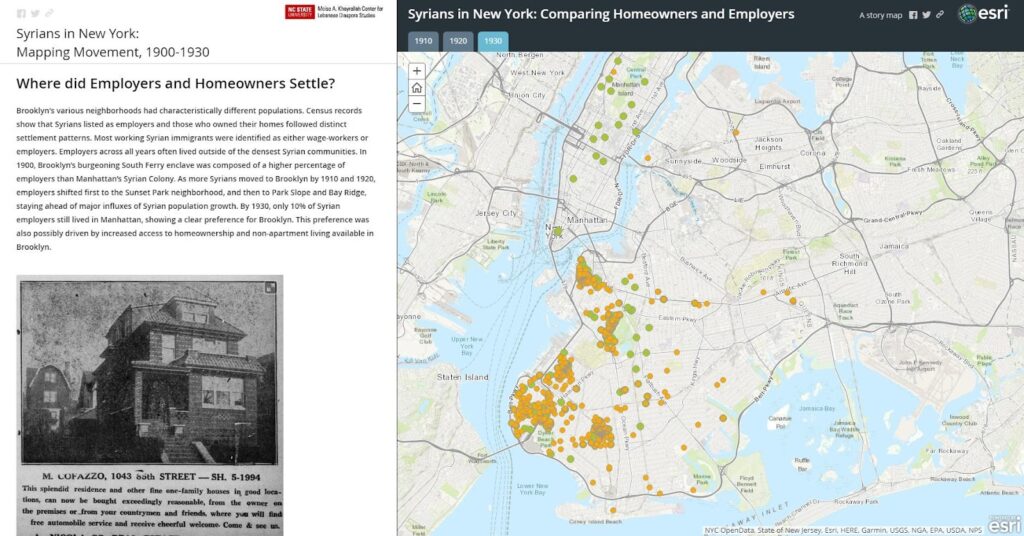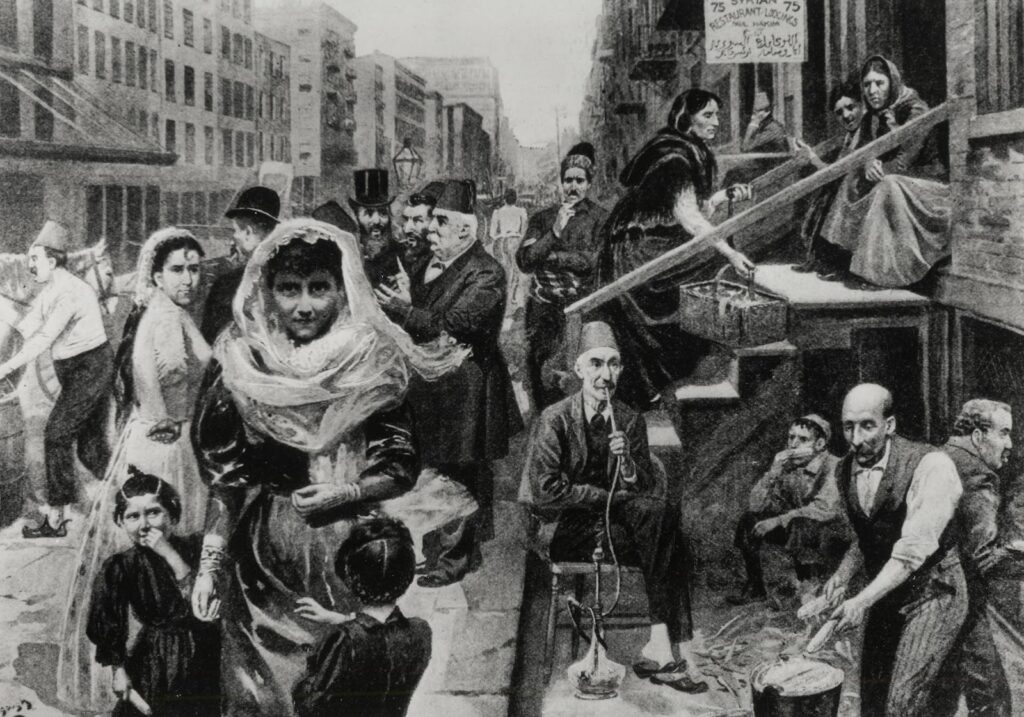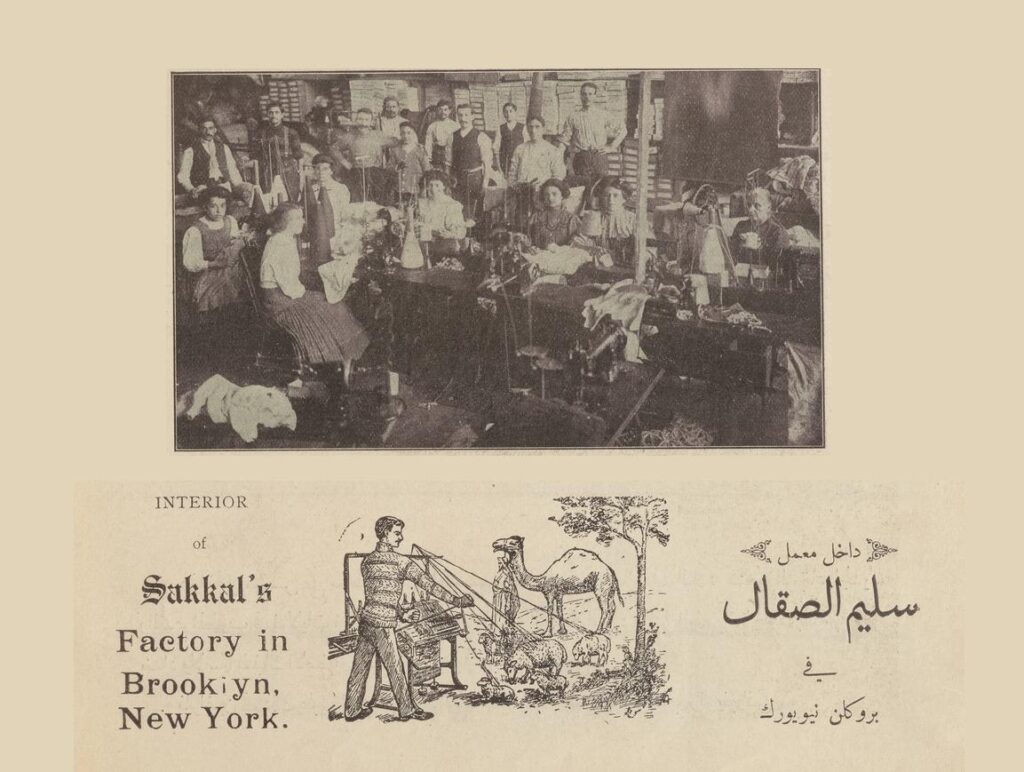Debut of Syrians in New York: Mapping Movement, 1900-1930
The Khayrallah Center’s newest project, Syrians in New York: Mapping Movement, 1900-1930, uses digital mapping techniques to investigate New York City’s early Syrian/Lebanese immigrant community. This project is a phase of the center’s larger project, Mapping the Mahjar. Syrians in New York examines immigrants’ movement from Manhattan’s Washington Street neighborhood to Brooklyn, employing spatial analysis to test existing theories and pose new explanations for what drove this move.
Scholars and the Syrian/Lebanese heritage community have held that moving to Brooklyn symbolized immigrants’ upward social and economic mobility and represented assimilation to American culture. Using census and other supplementary data, the Khayrallah Center challenged this theory. Researchers looked at settlement patterns, rates of marriage outside the community, immigrant occupations, work status, numbers of homeowners and renters, and sampled case studies of community residents. Ultimately, the center found that data did not support the theory that moving to Brooklyn correlated with a rise in class and Americanization. Instead our research suggests that while the community transplanted from one borough to another, it retained key elements of stability and a focus on ethnic enclaves. To explain the motive for movement, the study argues that a series of push and pull factors compelled immigrants to leave Manhattan while Brooklyn served as a logical and ideal destination. Among other things, these factors included encroaching commercial development in Manhattan, the availability of more spacious housing in Brooklyn, and a growth in transportation infrastructures across the East River connecting the two boroughs.
Studying Syrians in New York is important to understanding Syrian immigration throughout the United States. Virtually all Syrians in America were in some way tied to New York’s vibrant community. The Washington Street neighborhood was the original hub of Syrian immigration in the United States. The majority of immigrants from the Levant entered through the port of New York (specifically Ellis Island after 1892) and spent time in the city making connections, establishing roots, or getting their bearings before moving on to other parts of the country. Syrian-run textile and oriental goods factories in the city supplied peddlers throughout the U.S. Syrian publishers produced Arabic and English newspapers and magazines (such as Al-Hoda, Kawkab Amirka, and the Syrian World) that reached immigrants in cities and small rural towns across America.
Beginning in the late 1890s, many Syrians living around Washington Street began moving to Brooklyn and this movement increased over time. In Brooklyn, they settled in South Ferry, Park Slope, Bay Ridge, and Sunset Park. By 1910, the Brooklyn population surpassed Manhattan’s (reaching 10,000 by 1930), and ultimately, the hub of Syrian culture in New York City transferred to Brooklyn’s South Ferry neighborhood.
The complexity and significance of this community drew NC State Public History graduate students Katie Schinabeck, Claire Kempa, Ethan Ley, and Patrick Bizieff to research this community for a Digital Humanities class in the Fall of 2016. Using data samples from the 1900 and 1930 census, they examined why immigrants moved from Manhattan to Brooklyn. The group was honored with a nomination to present at the NCSU Graduate Student Research Symposium where the project received excellent reviews and was featured in an article by the College of Humanities and Social Sciences. In the Spring of 2017, in collaboration with the Khayrallah Center’s Senior Researcher Margie Stevens, Katie Schinabeck and Claire Kempa worked to enhance the project by adding complete census data from 1900 to 1930, an expansion that strengthened the historical arguments made. The project uses the cutting-edge Esri Story Maps platform to convey interactive maps alongside a historical narrative with images and multimedia. Detailed case studies highlight the individual stories of immigrants shedding light on the personal side of immigration in contrast to the larger demographic analysis that drives the project.
Take a look at Syrians in New York and we appreciate your feedback in the comments section below.
- Categories:




